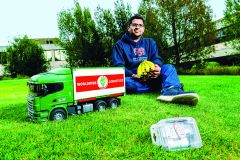Banana quality in supermarkets is on the improve and industry wastage on the decline, thanks to AMC PhD student Indika Fernando.
Indika unpeeled most of the reasons for less-than-pristine supermarket bananas during his three-and-half-year study Improving Banana Quality Through Supply Chain Management.
The study took him from the banana-growing plantations of far North Queensland to supermarket shelves in Melbourne.
During that time, he inspected more than 30,000 bananas to determine the nature of damage at each stage along the supply chain.
He provided recommendations to the $600 million banana industry on ways to improve quality in the post-harvest supply chain.
“My project was to identify the causes of damage and tell the industry how to minimise them,” he said.
Indika said 5 to 8 per cent of bananas in Australia were lost during post-harvest handling and distribution, a much higher wastage than comparative international markets.
“The problem was that damage which occurred throughout the supply chain remained latent until the cartons were opened for sale,” he said.
“This made it difficult to understand whether it occurred on the farm or the distribution centre or during transport and handling, or due to compression on fruits during storage.”
His study showed that the extremely lengthy supply chains in Australia meant bananas were prone to damage from vibration and shock during road transport.
Indika looked to quantify vibration and shocks that may cause defects in bananas during interstate transport that spans thousands of kilometres.
He inspected more than 30,000 bananas to determine the nature of damage at each stage along the supply chain
“We worked with Launceston’s Definium Technologies to develop sensors that captures the movement in trucks during the journeys,” he said.
He placed the sensors in trucks and inspected bananas at both despatch and destination.
“Then I could see what vibration and shock did to this fruit and model the damage levels in relation to the vibration intensity and duration of exposure,” he said.
Indika trialled solutions for minimising damage using state-of-the-art electrohydraulic simulators in the laboratory.
His recommendations included improved packaging, modifications to packing clusters and stacking arrangements in pallets, as well as several work-practice changes targeted at the industry to improve the postharvest quality of bananas.
His research is also supported by the ARC Training Centre for Innovative Horticultural Products, in collaboration with partners from the industry.
Published on: 24 Sep 2020

